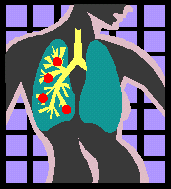|
Administering IPPB |
 |
IPPB therapy has traditionally been administered by means of a pressure-cycled ventilator with a prescribed, preset pressure limit. The key factor in an appropriately delivered, effective IPPB treatment is the RCP administering the treatment. In fact, many believe that the disparity seen in studies evaluating IPPB is caused largely by variance in administration by RCPs. The effectiveness of this and other respiratory modalities depends not on the equipment, but on the skills of the RCP. |
The factors needed to insure the successful administration of effective IPPB therapy include:
- a knowledgeable and well-trained
RCP who is completely familiar with the operation, maintenance, and
clinical application of the equipment
- a relaxed, informed,
and cooperative patient who meets the criteria for therapy and will
respond to and work with the therapist and equipment
- a concise concept of
therapeutic goals by the physician, RCP, and patient
- a pressure-limited machine
to accomplish maximal inspiration and a means of measuring VT
- appropriate coughing
and breathing instruction
- an objective appraisal by the RCP of whether the patient is benefiting from the therapy
Effective IPPB also requires that the RCP be involved in the following processes:
1. Preliminary planning: This stage involves:
- Determining that the
patient meets one or more of the indications previously described;
- Setting explicit and
measurable outcome goals for a given patient that are based on diagnostic
information that supports the need for IPPB therapy; The potential outcomes
of IPPB therapy include:
- Improved inspiratory or vital capacity
- Increased FEV1 or peak flow
- Enhanced cough and secretion clearance
- Improved chest X-ray
- Improved breath sounds
- Normalized arterial blood gases (for treating respiratory failure)
- Favorable patient subjective response
- Evaluating alternatives to determine whether simpler and less costly modalities might be as effective in achieving the desired outcomes.
2. Patient assessment: Prior to beginning therapy, the RCP should conduct a baseline patient assessment in order to allow objective evaluation of the patient's subsequent response to therapy, and alert the RCP to potential problems associated with administering IPPB to that specific patient. The more focused assessment should be individualized according to the identified clinical goals. The general assessment, common to all patients for whom IPPB is ordered, should include:
- Measurement of vital signs
- Observational assessment of the patient's appearance and sensonium
- Chest auscultation
3. Implementation: of IPPB treatment involves infection control, equipment preparation, patient orientation, and careful adjustment of the treatment parameters according to the patient's response.
- Standard infection control considerations to avoid transmission of infection between RCP and patient during IPPB therapy include:
- Use proper handwashing
technique
- Follow CDC universal precautions
- Follow CDC guidelines
for preventing spread of TB
- Observe all infection
control guidelines posted for patient
- Use only sterile diluents
and medications
- Disinfect all reusable
equipment between patients
- Change nebulizers or high-level
disinfect at conclusion of dose administration, or every 24 hours with
continuous use, or more often when visibly soiled
- Rinse nebulizers with sterile water only